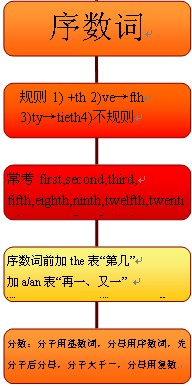本试题 “三、完形填空(本题有20小题,每小题1分,共20分)The old woman was wandering in the shop. She was ____31 ___; her clothes were torn; she gave off a s...” 主要考查您对序数词
等考点的理解。关于这些考点您可以点击下面的选项卡查看详细档案。
- 序数词
序数词的概念:
表示顺序的数称为序数词。如:first, second, third, fourth。
序数词的构成与用法:
1、序数词的构成:
①一般来说,是由相应的基数词加词尾th构成。
例:four+th→fourth
six+th→sixth
seven+th→seventh
ten+th→tenth
②下面这些基数词在变为序数词时,有特殊的变化。
例:one→first
two→second
three→third
five→fifth
eight→eighth
nine→ninth
twelve→twelfth
③十位整数序数词的构成方法是将基数词的词y变成i,然后再加eth。
例:twenty→twentieth
thirty→thirtieth
forty→fortieth
ninety→ninetieth
④两位或两位以上的基数词变成序数词时,仅将个位数变成序数词。
例:twenty-one→twenty-first
thirty-five→thirty-fifth
a hundred and fifty-three→a hundred and fifty-third
2、序数词的用法:
①序数词在使用时,一般加上定冠词。
例:the first book
the second floor
the third day
the fourth week.
②序数词在多数情况下都用作定语,有的也可以作表语、主语和宾语。
例:The may1st is Labour Day. 五月一日是劳动节。
My room is on the second floor. 我的房间在二楼。
The first is larger than the secon.(主语)第一个比第二个大。
Read the book from the first.(宾语)从开头读这本书。
You'll be the sixth to write.(表语)你将是第六个写的。
③序数词的前面可以加上不定冠词,用来表示“再一”,“又一”的意思。
例:You may have a third try. 你可以第三次尝试。
序数词知识体系:

约数的表达方法:
用tens/dozens/scores/hundreds/thousands/millions of 表示“几十、几百、上千、成千上万”等。
如:The boy bought dozens of pencils.
Thousands of people died in the earthquake.
注意: (A):dozen, score, hundred, thousand, million等表示确切数量时,不用复数。
如:five dozen (of) eggs 五打鸡蛋
hree hundred people 三百个人
分数词的构成和用法:
1)分数词构成法:
分数词(FractionalNumerals)由基数词和序数词构成,基数词代表分子,序数词代表分母。除了分子为1的情况下,序数词都要用复数形式:
如:1/4:one-fourth
5/9:five-ninths
2/3:two-thirds
17/5:three and two-fifths
7/12:seven-twelfths
379/8:forty-seven and three-eighths
此外还有下面表示法:
如:1/2:a(one) half
1/4:a(one) quarter
3/4:three-quarters
9/4:two and a quarter
3/2:one and half
31/4:seven and three quarters
与“三、完形填空(本题有20小题,每小题1分,共20分)The old wo...”考查相似的试题有:
- The early morning fire damaged the historic Gallad House today. It destroyed the third floor of the building so fire ...
- 共5小题;每小题2分,满分10分)根据短文内容,从短文后的选项中选出能填入空白处的最佳选项。选项中有两项为多于选项。(请把...
- Eye doctors recommend that a child’s first eye exam ________ at the age of six months old. A.wasB.beC.wereD.is
- Both of the two rulers are broken. I want to buy a _______ one.A.threeB.thirdC.forthD./
- For centuries people dreamed of going into space. This dream began to seem possible when high-flying rockets were bui...
- Don't worry about my illness. What I need is ________ but a few days' rest.A.anythingB.everythingC.somethingD.not...
- We have done a survey recently to find whom students will turn to 1.______when they in trouble .The following are the...
- Many interesting activities will be _____ in the summer camp to attract children .A.commandedB.organizedC.recogniz...
- 根据对话内容,从对话后的选项中选出能填入空白处的最佳选项。选项中有两项为多余选项。(请把此题的答案涂在答题卡相应的位...
- 根据下列句中的首字母或中文提示写出确当的单词:(5分)81. The volunteers were kept busy d________ food and drinks to t...